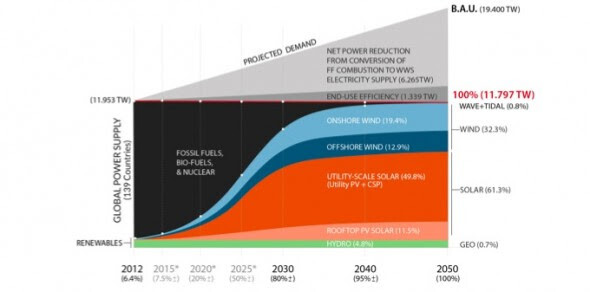New analysis from Stanford University has laid out a roadmap for 139 countries to power their economies with solar, wind, and hydro energy by 2050.
The Stanford study focuses on what it has dubbed “WWS” – wind, water and sunlight. And it includes not just electricity but transportation, heating and cooling, industry, and agriculture, forestry and fishing.
It says the world can reach 80 per cent “WWS” by 2030, which puts the Greens target for 90 per cent renewable energy for electricity only for Australia by the same date in a different perspective.
The roadmap outlines numerous benefits – millions of jobs, no impact on economic growth – and total savings from fuel costs, environment and climate damage of nearly $US5,000 a year.
Stanford estimates that it will save each person in the 139 countries an average of $170 a year on fuel costs, and $2,880 a year in air-pollution-damage cost and $US1,930/person/year in climate costs (2013 dollars).
They have even broken down the equipment and installations needed into each country. It appears eye watering, but Stanford says the land use requirements are minimal – just 0.29 per cent of the land area, mostly for solar PV, not including reclaimed fossil fuel plants.
Energy efficiency and changing industrial practises will be important. The average end use load will fall 39.2 per cent, with 82 per cent of this fall due to electrification and eliminating the need for mining, transport, and refining of conventional fuels.
The cost reductions come from the fact that that levellised costs of electricity for hydropower, onshore wind, utility-scale solar, and solar thermal for heat is already similar to or less than natural gas combined-cycle power plants.
And as the LCOE for rooftop PV, offshore wind, tidal, and wave energy fall below conventional fuels in coming years and decades.
Stanford says the major benefits of a conversion to WWS are the near-elimination of air pollution morbidity and mortality and global warming, net job creation, energy-price stability, reduced international conflict over energy because each country will be energy independent.
“Finally, the aggressive worldwide conversion to WWS proposed here will avoid exploding levels of CO2 and catastrophic climate change.”
© 2015 Solar Choice Pty Ltd
